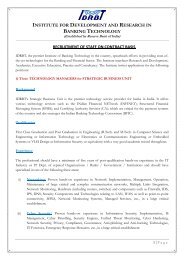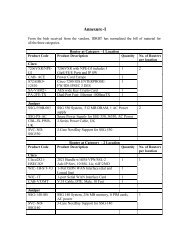New method for feature extraction based on fractal behavior - IDRBT
New method for feature extraction based on fractal behavior - IDRBT
New method for feature extraction based on fractal behavior - IDRBT
You also want an ePaper? Increase the reach of your titles
YUMPU automatically turns print PDFs into web optimized ePapers that Google loves.
1072 Y.Y. Tang et al. / Pattern Recogniti<strong>on</strong> 35 (2002) 1071–1081<br />
investigati<strong>on</strong>s of this new subject. Since Mandelbrot [1]<br />
proposedthis technique, the subject of <strong>fractal</strong> dimensi<strong>on</strong><br />
has drawn a great deal of attenti<strong>on</strong> from mathematicians,<br />
physicists, chemists, biologists, geologists, andelectrical<br />
andcomputer engineers in various disciplines. Specically,<br />
in the area of pattern recogniti<strong>on</strong> andimage processing,<br />
the <strong>fractal</strong> dimensi<strong>on</strong> has been used <str<strong>on</strong>g>for</str<strong>on</strong>g> image<br />
compressi<strong>on</strong>, texture segmentati<strong>on</strong> and<str<strong>on</strong>g>feature</str<strong>on</strong>g> <str<strong>on</strong>g>extracti<strong>on</strong></str<strong>on</strong>g><br />
[2–5], etc. The process of pattern recogniti<strong>on</strong> requires<br />
the <str<strong>on</strong>g>extracti<strong>on</strong></str<strong>on</strong>g> of <str<strong>on</strong>g>feature</str<strong>on</strong>g>s from regi<strong>on</strong>s of the image, and<br />
the processing of these <str<strong>on</strong>g>feature</str<strong>on</strong>g>s with a pattern classicati<strong>on</strong><br />
algorithm. Many applicati<strong>on</strong>s of <strong>fractal</strong> c<strong>on</strong>cepts<br />
rely <strong>on</strong> the ability to estimate the <strong>fractal</strong> dimensi<strong>on</strong> of<br />
objects. One of the basic characteristics of a <strong>fractal</strong> is its<br />
dimensi<strong>on</strong>. A <strong>fractal</strong> object can be characterized by its<br />
dimensi<strong>on</strong> which is a way of interpretati<strong>on</strong>, determines<br />
how much “space” it occupies between arbitrary m and<br />
m+1 dimensi<strong>on</strong>al manifolds. This <str<strong>on</strong>g>feature</str<strong>on</strong>g> has been used<br />
in texture classicati<strong>on</strong>, segmentati<strong>on</strong>, shape analysis<br />
andother problems [6–8]. All these approaches face and<br />
attempt to solve two basic problems: (1) accuracy of the<br />
estimate, (2) amount of in<str<strong>on</strong>g>for</str<strong>on</strong>g>mati<strong>on</strong> needed to obtain the<br />
estimate. In this paper, we utilize a <str<strong>on</strong>g>method</str<strong>on</strong>g>called“ box<br />
counting dimensi<strong>on</strong>” to estimate the <strong>fractal</strong> dimensi<strong>on</strong><br />
of an image. All of these <str<strong>on</strong>g>feature</str<strong>on</strong>g>s rely <strong>on</strong> computing the<br />
mass probability density functi<strong>on</strong> <str<strong>on</strong>g>based</str<strong>on</strong>g> <strong>on</strong> the central<br />
projecti<strong>on</strong> trans<str<strong>on</strong>g>for</str<strong>on</strong>g>mati<strong>on</strong> andwavelet decompositi<strong>on</strong><br />
<str<strong>on</strong>g>for</str<strong>on</strong>g> the <strong>fractal</strong> set. We analyze the box counting <str<strong>on</strong>g>method</str<strong>on</strong>g>ology<br />
from the standpoint of computing <strong>fractal</strong> <str<strong>on</strong>g>feature</str<strong>on</strong>g>s.<br />
We focus <strong>on</strong> <strong>fractal</strong> dimensi<strong>on</strong> <str<strong>on</strong>g>for</str<strong>on</strong>g> computing the <strong>fractal</strong><br />
signature. This c<strong>on</strong>cept can be useful in the measurement<br />
andclassicati<strong>on</strong> of pattern’s <str<strong>on</strong>g>feature</str<strong>on</strong>g>s.<br />
2. Basic theory and algorithm<br />
Fractal theory is <str<strong>on</strong>g>based</str<strong>on</strong>g><strong>on</strong> geometry anddimensi<strong>on</strong><br />
theories. Fractals are mathematical sets with a high degree<br />
of geometrical complexity, which can model many<br />
classes of time series data as well as images. The <strong>fractal</strong><br />
dimensi<strong>on</strong> is an important characteristic of <strong>fractal</strong>s because<br />
it c<strong>on</strong>tains in<str<strong>on</strong>g>for</str<strong>on</strong>g>mati<strong>on</strong> about their geometric structure.<br />
It has become an eective tool to study complex<br />
sets. There are many deniti<strong>on</strong>s <str<strong>on</strong>g>for</str<strong>on</strong>g> the <strong>fractal</strong> dimensi<strong>on</strong>s<br />
of a <strong>fractal</strong> set [9,10]. The simplest andmost appealing<br />
way of assigning a dimensi<strong>on</strong> to a set that can yield a<br />
<strong>fractal</strong> dimensi<strong>on</strong> to certain kinds of sets is the so-called<br />
box dimensi<strong>on</strong>. In the secti<strong>on</strong>, the important c<strong>on</strong>cept and<br />
algorithm about box dimensi<strong>on</strong> and modied algorithm<br />
of <strong>fractal</strong> dimensi<strong>on</strong> will be introduced.<br />
2.1. Fractal dimensi<strong>on</strong><br />
Fundamental to most deniti<strong>on</strong>s of dimensi<strong>on</strong> is the<br />
idea of measurement at scale . For each , a set can be<br />
measuredin a way that ignores irregularities of size less<br />
than , andwe see how these measurements behave as<br />
→ 0.<br />
Suppose F is a plane curve, the measurement M (F)<br />
denotes the number of sets (with length ) which divide<br />
the set F. A dimensi<strong>on</strong> of F is determined by the power<br />
law obeyedby M (F) as → 0. If<br />
M (F) ∼ K −s ; (1)<br />
<str<strong>on</strong>g>for</str<strong>on</strong>g> c<strong>on</strong>stants K and s, we might say that F has dimensi<strong>on</strong><br />
s, and K can be c<strong>on</strong>sidered as “s-dimensi<strong>on</strong>al length”<br />
of F.<br />
Taking the logarithm of both sides in Eq. (1) yields<br />
the <str<strong>on</strong>g>for</str<strong>on</strong>g>mula:<br />
log 2 M (F) ≃ log 2 K − s log 2 ;<br />
in the sense that the dierence of the two sides tends<br />
to 0 with , this suggests that the box dimensi<strong>on</strong> of F,<br />
denoted by dim(F), shouldsatisfy<br />
log<br />
dim(F) = lim 2 M (F)<br />
→0 −log 2 : (2)<br />
If the limit exists, dim(F) is calledthe <strong>fractal</strong> dimensi<strong>on</strong><br />
of set F.<br />
2.2. Box counting dimensi<strong>on</strong> (BCD)<br />
Box computing dimensi<strong>on</strong> or box dimensi<strong>on</strong> is <strong>on</strong>e of<br />
the most widely used dimensi<strong>on</strong>s. Its popularity is largely<br />
due to its relative ease of mathematical calculati<strong>on</strong> and<br />
empirical estimati<strong>on</strong>.<br />
Let F be a n<strong>on</strong>-empty andboundedsubset of<br />
R n ;= {! i : i =1; 2; 3;:::} be covers of the set F. N (F)<br />
denotes the number of covers, such that<br />
N (F)=|: d i 6 |;<br />
where d i stands <str<strong>on</strong>g>for</str<strong>on</strong>g> the diameter of the ith cover. This<br />
equati<strong>on</strong> means that N (F) is the smallest number of<br />
subsets which cover the set F, andtheir diameters d i ’s<br />
are not greater than .<br />
The upper andlower bounds of the box computing<br />
dimensi<strong>on</strong> of F can be dened by the following <str<strong>on</strong>g>for</str<strong>on</strong>g>mulas:<br />
log<br />
dim B F = lim 2 N (F)<br />
→0 −log 2 ;<br />
log<br />
dim B F = lim 2 N (F)<br />
→0 −log 2 ; (3)<br />
where the overline stands <str<strong>on</strong>g>for</str<strong>on</strong>g> the upper bound of dimensi<strong>on</strong><br />
while the underline <str<strong>on</strong>g>for</str<strong>on</strong>g> lower bound.<br />
If both the upper bounddim B F andthe lower bound<br />
dim B F are equal, i.e.<br />
log<br />
lim 2 N (F)<br />
→0 −log 2 <br />
= lim log 2 N (F)<br />
→0 −log 2 ;

















